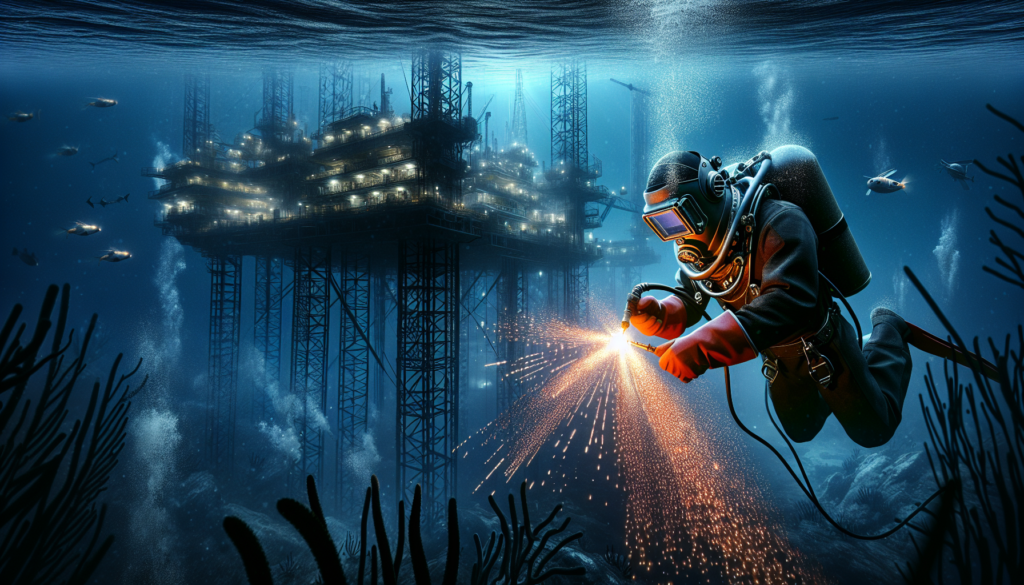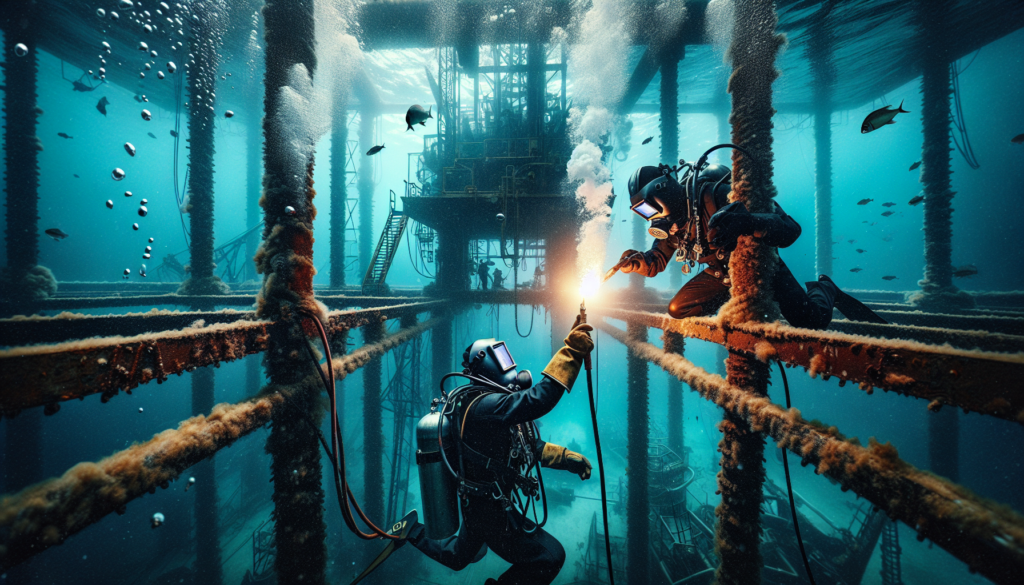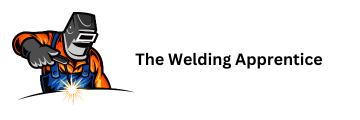Imagine being deep below the surface, surrounded by the vast expanse of the ocean, with the weight of the water pressing in on you from all sides. Now, picture yourself equipped with welding gear, seamlessly fusing metal together in the most challenging conditions. This is the world of underwater welders, a group of skilled professionals who brave the depths to perform a task as crucial as it is perilous – welding on oil rigs. In this article, we will explore the fascinating field of underwater welding on oil rigs, delving into the unique skills required and the risks faced by these unsung heroes of the offshore industry.

Overview of Underwater Welding
Definition of underwater welding
Underwater welding is a specialized welding technique that is performed underwater, typically in marine environments such as oceans, lakes, or rivers. It involves the fusion of metal materials to create a strong and durable joint or connection. Unlike traditional welding techniques that are performed on land, underwater welding requires specialized equipment and training to ensure safety and efficiency.
Importance of underwater welding on oil rigs
Underwater welding plays a crucial role in the maintenance and repair of oil rigs. Oil rigs are exposed to harsh offshore conditions, including corrosive saltwater and constant wave action. Over time, these environmental factors can cause damage to the structure and equipment of the rig. Underwater welding allows for timely repairs and preventive maintenance, helping to ensure the integrity and functionality of the rig.
Challenges of underwater welding
Underwater welding poses several challenges that make it a unique and demanding profession. Working underwater introduces additional obstacles compared to land-based welding, such as limited visibility, restricted mobility, and increased pressure. Furthermore, underwater welders must deal with unpredictable aquatic conditions, strong currents, and the risk of encountering marine life. These challenges require welders to have specialized skills and equipment to perform their work safely and effectively.
Types of Underwater Welding
Wet Welding
Wet welding, also known as direct current welding, is a common method used in underwater welding. It involves the use of welding equipment and electrodes that can function effectively under water. This technique utilizes a waterproof electrode holder and special coating on the electrode to prevent contact with water. Wet welding is often used for quick repairs and maintenance tasks where complete dry conditions cannot be achieved.
Dry Welding
Dry welding, also known as hyperbaric welding, is a technique that involves creating a dry, enclosed environment around the welding area. This is accomplished by using large structures or chambers called habitats, which provide a controlled environment for welding. Dry welding eliminates exposure to water and allows for the use of conventional welding equipment. It is commonly employed for large-scale projects or when a high-quality weld is required.
Hyperbaric Welding
Hyperbaric welding, a subcategory of dry welding, is a technique performed in a high-pressure environment. It involves sealing the working area with a hyperbaric chamber and pressurizing it with a gas mixture. This pressurization prevents water from entering the welding zone and allows for conventional welding to be performed. Hyperbaric welding is commonly used in deep-sea applications or projects that require welds to be completed at significant depths.
Training and Certification
Required qualifications for underwater welders
Becoming an underwater welder requires a combination of specialized skills and certifications. Apart from basic welding knowledge, underwater welders need to be certified commercial divers. They must possess excellent diving skills, including the ability to handle different diving apparatus, deal with emergency situations, and maintain their composure underwater. Additionally, underwater welders should have a strong understanding of welding principles and techniques to ensure sound and reliable welds.
Training programs for underwater welding
Several institutions and organizations offer training programs specifically designed for underwater welding. These programs cover a wide range of topics, including diving techniques, welding processes, safety procedures, equipment maintenance, and project management. The training programs may consist of classroom instruction, hands-on practical sessions, and simulated underwater welding exercises. It is important for aspiring underwater welders to enroll in reputed training programs that align with industry standards and provide certifications upon completion.
Certification process
To work as an underwater welder, certification is essential. Certification ensures that welders meet industry standards and possess the necessary skills to perform their work safely and effectively. Various organizations, such as the American Welding Society (AWS) and the International Marine Contractors Association (IMCA), offer certification programs for underwater welders. These certifications typically require candidates to pass written exams, practical assessments, and demonstrate proficiency in welding and diving skills. Maintaining certification often requires periodic renewal and continuing education.
Safety Measures
Hazards of underwater welding
Underwater welding presents several hazards that must be managed to ensure the safety of divers and welders. The most common hazards include electric shock, explosion or fire, decompression sickness, and physical injuries from equipment or marine life. Working in a submerged environment adds complexity to already hazardous welding processes. The presence of water can create unpredictable electrical paths, increase the risk of arc strikes, and impact the welding quality. Proper safety measures, equipment, and procedures are crucial to mitigate these risks.
Safety equipment and procedures
Underwater welders must adhere to strict safety protocols and utilize specialized safety equipment to minimize risks. Personal protective equipment (PPE), such as diving suits, helmets, gloves, and boots, are essential to protect against cold water, pressure differentials, and physical injuries. Additionally, electrical safety measures, such as the use of insulated tools and equipment, grounding, and proper electrical isolation, help prevent electric shock hazards. Regular safety briefings, emergency procedures, and continuous monitoring of the work environment are also critical components of maintaining a safe working environment.
Health risks for underwater welders
In addition to the hazards associated with welding and diving, underwater welders face unique health risks due to prolonged exposure to high-pressure environments and underwater conditions. Conditions such as diving-induced respiratory diseases, nitrogen narcosis, and decompression sickness can be potentially life-threatening if not managed properly. Regular health check-ups, rest periods between dives, proper air and gas mixtures, and adherence to safe diving practices are crucial for mitigating these health risks.

Equipment and Tools
Diving equipment for underwater welders
Underwater welders rely on specialized diving equipment to perform their work safely and efficiently. This equipment includes diving suits, helmets, boots, gloves, and communication systems. Diving suits provide protection against cold water, water pressure, and potential injuries from marine life. Helmets, equipped with lights and communication devices, allow for clear communication and illumination in dark underwater environments. Boots and gloves provide additional protection and grip, ensuring stability during welding tasks.
Unique tools used in underwater welding
Underwater welding requires the use of specific tools designed to function effectively in wet or submerged conditions. These tools include underwater welding electrodes, torches, fluxes, wire brushes, and grinding wheels. Welding electrodes are specially coated to prevent contact with water and ensure efficient arc transfer underwater. Torch configurations are designed to withstand water and provide a stable flame for cutting or heating tasks. Proper cleaning tools, such as wire brushes and grinding wheels, are used to prepare the welding surface and remove any contaminants or coatings.
Importance of maintaining equipment
Regular maintenance and inspection of diving equipment and underwater welding tools are crucial for the safety and effectiveness of underwater welding operations. Equipment should be inspected before each dive to ensure it is in proper working condition and free from defects. Routine maintenance includes cleaning, greasing, and replacing worn-out components. Additionally, regular testing of communication systems, lighting devices, and emergency equipment is essential for maintaining optimal functionality. Proper equipment maintenance helps minimize the risk of equipment failure and improves overall performance during underwater welding projects.
Welding Techniques
Welding methods used underwater
Various welding methods can be employed for underwater welding, depending on the specific requirements of the project. Common welding techniques used underwater include shielded metal arc welding (SMAW), gas tungsten arc welding (GTAW), and flux-cored arc welding (FCAW). SMAW is the most widely used method and is suitable for a wide range of materials and joint types. GTAW is commonly used for precision welding tasks, while FCAW provides higher deposition rates, making it ideal for larger-scale projects.
Considerations for different joint types
Underwater welders must consider different joint types and their associated challenges when performing underwater welding. The complexity of the joint, such as its geometry, accessibility, and thickness, may require specific welding techniques and approaches. Butt joints, fillet joints, and T-joints are common joint configurations encountered in underwater welding. The choice of welding method, electrode composition, and welding parameters should be carefully determined to ensure the integrity and strength of the welded joint.
Factors affecting welding parameters
Underwater welding parameters, including current type, voltage, electrode composition, arc length, and travel speed, are critical factors that influence the quality and performance of the weld. Underwater conditions, such as water temperature, current flow, depth, and visibility, must be taken into account when selecting and adjusting welding parameters. These parameters should be carefully controlled to achieve optimal weld penetration, minimize porosity and defects, and ensure the overall quality and durability of the weld.
Preparation for Underwater Welding
Inspection and cleaning of the welding area
Before initiating any underwater welding task, thorough inspection and cleaning of the welding area are vital. The area must be carefully examined to identify any structural damage, cracks, or defects that could affect the welding process or compromise the integrity of the final weld. Cleaning of the welding area involves the removal of marine growth, rust, coatings, or any other contaminants that could hinder the welding process. Proper surface preparation ensures the creation of a clean, well-prepared surface for successful welding.
Coating removal process
The presence of coatings, such as paints, corrosion inhibitors, or protective layers, on the welding surface can interfere with the welding process and compromise the quality of the weld. Underwater welders utilize a variety of coating removal techniques to ensure a clean and properly prepared surface. Methods such as brushing, grinding, water jetting, or the use of specialized coating removal tools are employed to remove coatings effectively. The choice of the coating removal process depends on the type of coating, the condition of the surface, and the specific requirements of the welding project.
Preventing water ingress during the welding process
Water ingress is a significant concern during underwater welding, as it can compromise the weld and introduce defects or weaknesses. To prevent water from entering the welding area, various techniques are used, depending on the welding method employed. For wet welding, a specific electrode coating is applied to minimize water contact and enhance the electrical properties of the welding arc. Dry welding methods utilize enclosed habitats or hyperbaric chambers that create a dry environment around the welding area, preventing water ingress and ensuring the success of the welding process.
Process of Underwater Welding
Surface preparations before diving
Before diving for underwater welding, proper surface preparations are essential to ensure the diver’s safety and facilitate a smooth dive. The work area must be clearly marked and secured to prevent accidental access by other personnel or vessels. All necessary equipment and tools are checked and prepared, ensuring they are in proper working condition. Communication systems, lighting devices, and emergency equipment are also tested to ensure their functionality. Proper planning, organization, and coordination among the diving team members contribute to a safe and efficient diving process.
Setup of welding equipment underwater
Once the diver reaches the intended welding site, they begin the process of setting up the welding equipment underwater. This involves connecting the welding cables to the power source and securing them to prevent tangling or entanglement. The appropriate welding electrode is selected and inserted into the electrode holder, ensuring it is securely positioned for welding. The diver verifies the connection and functionality of the welding equipment, confirming that all electrical and safety components are in place before initiating the welding process.
Execution of the welding process
Underwater welding requires a high level of skill, precision, and concentration from the diver. The diver positions themselves appropriately to ensure a clear view of the welding area, using support structures or fixtures to stabilize their position. They initiate the welding process by striking an arc and carefully controlling the position and motion of the electrode to create a strong, secure weld. The diver maintains constant awareness of their surroundings, water depth, welding parameters, and potential hazards, ensuring the successful completion of the welding project underwater.
Quality Control
Importance of inspections
Inspections are a crucial component of maintaining the quality and integrity of underwater welds. Regular inspections conducted before, during, and after the welding process help identify any defects, discontinuities, or areas of concern that may compromise the weld’s performance or longevity. Inspections also allow for the verification of compliance with specified codes, standards, and project requirements. By implementing a comprehensive inspection process, underwater welders and project managers can ensure that weld quality meets or exceeds industry standards and client expectations.
Non-destructive testing methods
Non-destructive testing (NDT) methods are employed to evaluate the quality and integrity of underwater welds without causing damage to the welded joint. Common NDT techniques used for underwater welding include visual inspection, magnetic particle testing, ultrasonic testing, and radiographic testing. Visual inspection allows for a direct assessment of the weld’s surface condition, while magnetic particle testing detects surface or near-surface defects. Ultrasonic and radiographic testing provide a detailed examination of the weld’s internal structure and detect any hidden or subsurface defects that may compromise its performance.
Ensuring the integrity of welded joints
To ensure the integrity of welded joints, various quality control measures are implemented during and after the welding process. These measures include proper weld sequencing, compliance with welding procedures and specifications, the use of appropriate weld symbols and indications, and effective heat control. Quality control checks for factors such as weld penetration, continuity, dimensions, and the absence of defects such as cracks, porosity, or lack of fusion. By diligently following quality control procedures, underwater welders can achieve sound, reliable welds that meet the necessary strength and performance requirements.
Repair and Maintenance
Common welding defects and their causes
Underwater welds are susceptible to various defects that can compromise their performance and structural integrity. Common welding defects encountered during underwater welding include porosity, lack of fusion, cracks, inclusions, and undercutting. These defects can arise due to improper welding techniques, incorrect welding parameters, inadequate surface preparation, or the presence of contaminants. Identifying the root causes of these defects is essential for implementing effective repair and preventive measures, ensuring the longevity and functionality of underwater welds.
Methods for repairing underwater welds
Repairing underwater welds requires a combination of welding techniques, inspection, and surface preparation methods. Defective welds are identified through visual inspection or non-destructive testing methods, and the appropriate repair technique is determined based on the type and severity of the defect. Repair methods may include grinding and re-welding, adding additional weld material, or conducting a complete redo of the weld. Surface preparation techniques, such as cleaning, coating removal, and re-inspection, are implemented before initiating the repair process to ensure a successful weld repair.
Routine maintenance of welds on oil rigs
Routine maintenance of welds on oil rigs is vital to ensure the long-term performance and integrity of the structures. This includes regular inspections for signs of corrosion, cracking, or wear, as well as preventative measures such as surface cleaning and coating application. Routine maintenance activities may also involve identifying potential areas of concern, such as joints, connections, or stress points, and implementing appropriate repair or reinforcement measures. By proactively maintaining welds on oil rigs, potential risks and costly repairs can be minimized, extending the lifespan and reliability of the structures.
In conclusion, underwater welding plays a critical role in the maintenance and repair of oil rigs. The technique involves unique challenges and requires specialized equipment, training, and certification. Safety measures and equipment are crucial to mitigate hazards associated with underwater welding, while proper preparation and execution of the welding process ensure quality and integrity. Additionally, regular inspections, routine maintenance, and effective repair techniques contribute to the long-term performance and durability of underwater welds. Underwater welding is a specialized field that demands skilled professionals who can navigate the complexities of working in underwater environments to maintain the integrity of vital structures such as oil rigs.
